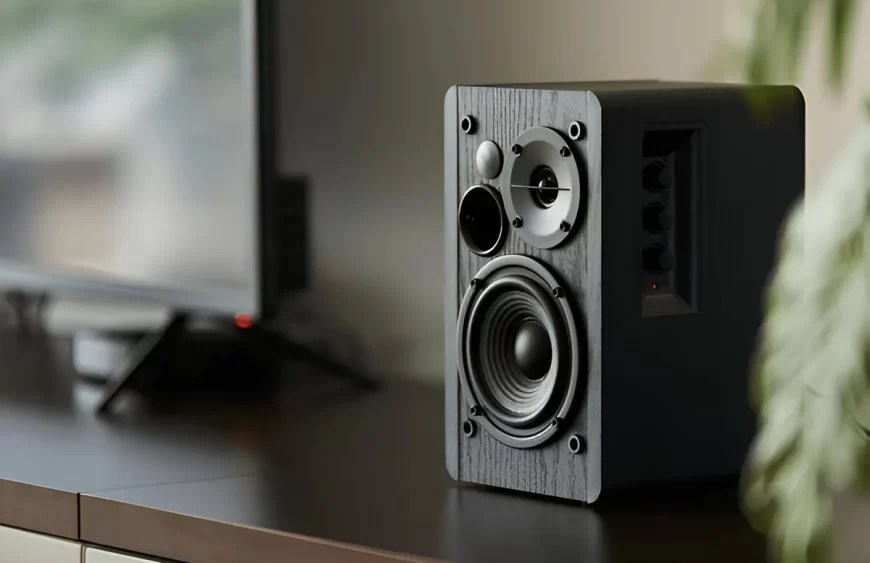Stands or No Stands? What Every Listener Should Know About Bookshelf Speaker Placement

~ This blog explores whether bookshelf speakers perform better with bookshelf speaker stands, diving into acoustic principles, placement tips, and how setup choices impact sound quality.
There’s an unmistakable joy in the crisp clarity of a well-placed pair of bookshelf speakers. Whether you’re a seasoned audiophile or someone who simply wants better sound from their setup, where and how you place your speakers makes a world of difference. One of the most frequently debated topics in home audio? Whether bookshelf speakers truly need bookshelf speaker stands—or if they can sit comfortably on any surface. The answer isn’t one-size-fits-all, but the right decision can dramatically elevate your listening experience.
The Science Behind Sound Placement
Sound waves interact with their environment—walls, furniture, and even your flooring. Unlike floor-standing models, bookshelf speakers are designed to sit at ear level in a near-field listening arrangement. Poor placement can cause sound waves to bounce erratically, leading to muddled mids and distorted bass. It’s not just about convenience or aesthetics; it’s about preserving the integrity of the audio.
This is why many audiophiles recommend elevating bookshelf speakers rather than just placing them on desks, shelves, or media units. This is where the debate about bookshelf speaker stands truly begins.
Why Speaker Stands Matter
Let’s start with the core function: isolation. Bookshelf speaker stands reduce vibrations transferring into nearby surfaces, which in turn minimizes unwanted resonances. When a speaker is placed on a wooden shelf, the surface often acts as a secondary soundboard, coloring the audio with extra reverberations. Bookshelf speaker stands often come with isolation pads or spikes designed to decouple the speaker from the floor or stand material. This results in cleaner mids, tighter bass, and an overall more faithful reproduction of sound.
Another key advantage? Optimal height. A general rule of thumb in audio setups is to position your speakers so the tweeters are at ear level while seated. Most speaker stands are built with this principle in mind, helping deliver a more immersive and accurate soundstage.
The Case for Going Stand-Free
That said, not every listener needs to rush to invest in a new pair of bookshelf speaker stands. If your existing furniture places your speakers at approximately ear level, and you’ve taken steps to reduce surface vibrations (like using foam pads), you might already be in a good spot.
Moreover, some speaker models are specifically tuned to work well against walls or in tighter spaces—especially when used with adaptable furniture solutions like a monitor lift that can double as an elevation platform. These exceptions aside, many mass-market bookshelf speakers still benefit from a little breathing room—which speaker stands typically provide.
However, when stands aren’t an option due to budget, room size, or design constraints, you can experiment with DIY alternatives. Isolating pads, rubber feet, or repurposed side tables can act as makeshift platforms—though not always with the same acoustic benefit.
Room Acoustics: The Invisible Influencer
Before deciding where to place your speakers, it’s worth spending a moment considering your room. Hard floors, bare walls, and glass surfaces are highly reflective and can interfere with audio clarity. Carpeted flooring, area rugs, and curtains help absorb excess reverb, ensuring your speakers perform at their best—stands or no stands.
Corner placement, for instance, can result in boomy, exaggerated bass due to boundary reinforcement. Pulling the speakers slightly away from the wall, preferably on bookshelf speaker stands, can help resolve this.
Stereo Imaging and Sweet Spots
One of the biggest pleasures of a good speaker setup is achieving that magical “sweet spot”—where stereo imaging locks in, and it feels like the artist is performing right in front of you. Stands make this process more precise by helping align both speakers symmetrically and at consistent angles. Adjustable speaker stands also allow for subtle toe-in adjustments, which can significantly enhance stereo separation and clarity.
When you place speakers on an uneven or cluttered surface, it becomes harder to dial in these precise angles. Even minor inconsistencies in speaker height or tilt can affect imaging and introduce phase issues.
Aesthetic Considerations
Let’s be honest—looks matter too. Stands bring a professional, balanced look to your audio setup. They can turn your bookshelf speakers from an afterthought to a centerpiece. Many modern stands are minimalistic, designed to blend with your room décor while providing crucial functional benefits. Additionally, cable management options often built into the stand help maintain a clean setup.
Of course, if you’re working with a modern entertainment unit or a dedicated audio rack that positions your speakers perfectly, the aesthetic difference may be negligible.
Port Positioning and Breathing Room
Bookshelf speakers often have either front or rear-firing ports. Rear-ported speakers especially benefit from being placed away from walls to avoid bass boominess. This is where stands again show their worth—allowing placement further from the wall than traditional furniture setups would allow.
Front-ported models offer more flexibility and are slightly more forgiving in terms of placement. However, even these can sound noticeably better when allowed space to “breathe.”
Final Verdict: To Stand or Not to Stand?
If you care deeply about accurate audio reproduction, controlled bass response, and immersive stereo imaging, speaker stands are a worthwhile investment. They provide stability, isolation, height accuracy, and aesthetic polish. That doesn’t mean they’re a must-have in every scenario—but they do offer measurable improvements in most.
On the flip side, for casual listeners or those with limited space, thoughtful placement using existing furniture and isolation solutions can still deliver a satisfying experience. The key is to be intentional with your setup—not just place your speakers wherever they fit.
In Conclusion
Getting the most out of your bookshelf speakers requires more than just buying a great pair—you need to create the right environment for them to shine. Whether that means investing in quality stands or getting creative with what you have, placement is a powerful factor in unlocking high-fidelity audio at home. Take your time, experiment, and trust your ears.
Discover Precision-Engineered Bookshelf Speaker Stands
For those looking to elevate their listening experience, Tono Systems offers a range of precision-crafted bookshelf speaker stands engineered to maximize performance and aesthetic appeal. Built on core acoustic principles, these stands blend form and function to offer richer, clearer, and more immersive sound—no matter the room.

